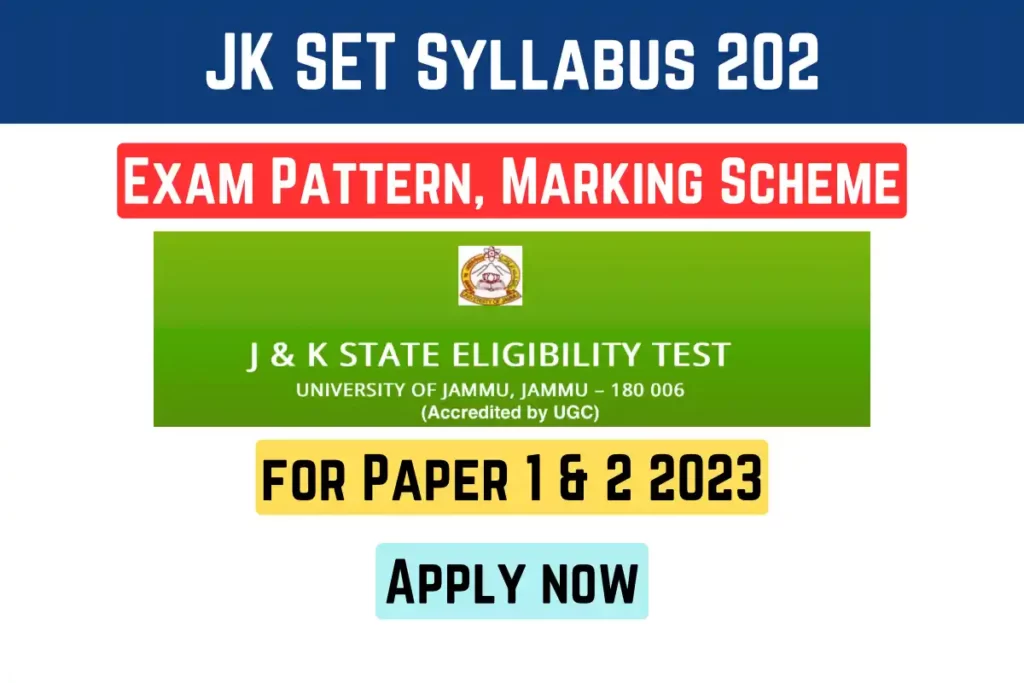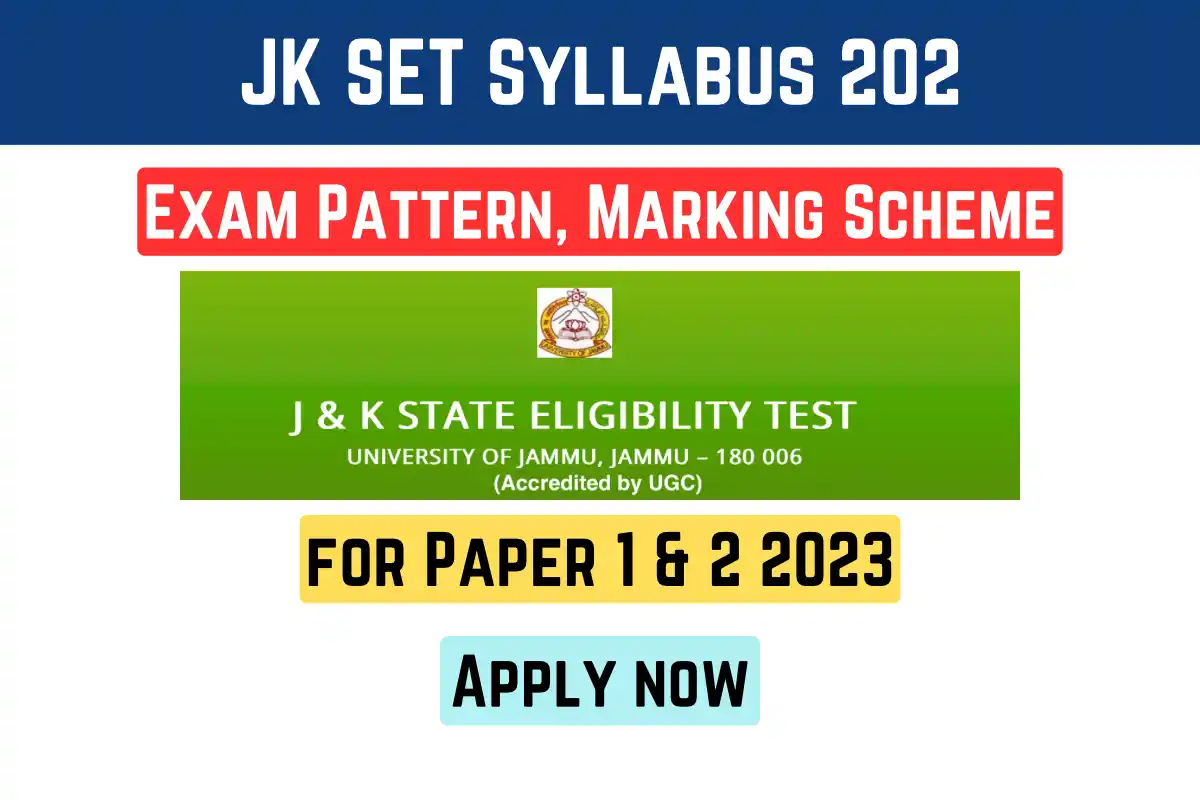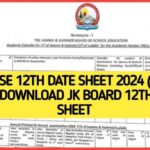JK SET Syllabus 2023: The JK SET syllabus for 2023 plays a crucial role in assessing candidates’ knowledge in their chosen subject areas. It is essential for aspirants to fully understand the syllabus and exam format before embarking on their JK SET exam preparation.
Similar to the UGC NET syllabus, the JK SET syllabus comprises two papers: Paper 1, a universal section, and Paper 2, which focuses on the specific subject chosen during the application process.
Aspirants are advised to consult the JK SET Syllabus PDF to carefully review all topics and subtopics, assisting in the development of a comprehensive study plan. The latest JK SET syllabus for Paper 1 and Paper 2, along with downloadable PDF files, is provided for candidates planning to take the exam. It is crucial for aspirants to thoroughly go through the listed syllabus below and commence their preparations accordingly.
JK SET Syllabus 2023
The JK SET Syllabus for 2023 is designed to assess candidates’ knowledge in their chosen subject areas. It is crucial for candidates to have a thorough understanding of the syllabus and exam format before commencing their preparation. The syllabus serves as a foundation in the preparation journey for each candidate.

Following the structure of the UGC NET syllabus, the JK SET Syllabus consists of two papers: Paper 1, a general section, and Paper 2, specific to the chosen subject during the application process. Aspirants are strongly advised to consult the JK SET Syllabus 2023 PDF, carefully reviewing all topics and subtopics to facilitate the creation of a well-organized study plan.
Jammu to Srinagar Train Update: Kashmir Valley To Welcome First Direct Train From Jammu
JK SET Syllabus 2023 Overview
The Jammu and Kashmir State Eligibility Test (JK SET) is conducted to determine candidates’ eligibility for the position of Assistant Professor in universities and colleges across Jammu and Kashmir. The JK SET 2023 syllabus is designed to evaluate candidates’ knowledge and proficiency in their chosen subject.
The exam typically consists of two papers: Paper-I, common for all candidates, tests general aptitude and research aptitude, while Paper-II assesses the candidate’s expertise in the chosen subject.
Paper-I syllabus includes teaching aptitude, reasoning ability, comprehension, and divergent thinking. Paper-II focuses on the specific subject chosen by the candidate, covering a range of topics relevant to that discipline.
It is crucial for aspirants to thoroughly review the prescribed JK SET 2023 syllabus to prepare comprehensively and enhance their chances of success in this competitive examination.
| JK SET Result 2023 Overview | |
| Particulars | Events |
| Exam Name | Jammu & Kashmir State Eligibility Test (JK SET)/ Ladakh State Eligibility Test (LASET) |
| Exam Level | State |
| Exam Duration | 3 hours |
| Exam Mode | Offline |
| Language of Exam | English and Hindi |
| No. of Exam City Centers | Three – Jammu, Srinagar, and Leh |
| JK SET Result 2023 Website | jammuuniversity.ac.in |
JK SET Syllabus 2023 PDF
Accessing the JK SET syllabus PDF is crucial for candidates, as it offers a detailed outline of covered topics and subtopics. This aids in planning preparation, allocating time and resources accordingly, and focusing on more crucial topics requiring heightened attention.
Moreover, the JK SET syllabus PDF delineates the exam pattern, marking scheme, and section weightage. Understanding these aspects provides insight into the exam’s format and section significance. As a result, candidates can instantly download the PDF for JK SET Syllabus 2023 by following the provided link.
JK SET Syllabus 2023 for Paper 1
JK SET Paper 1 focuses on Teaching and Research Aptitude. This section evaluates candidates’ teaching skills, reasoning, reading comprehension, divergent thinking, and general awareness. The JK SET Paper 1 syllabus includes content from 10 units, with five questions of two marks each from every unit. Take a detailed look at the outlined JK SET syllabus Paper 1 provided below:
| JK SET syllabus Paper 1 | ||
| Unit | Topic | Subtopics |
| UnitI: Teaching Aptitude | Teaching | Concept, Objectives Levels of teaching (Memory, Understanding, Reflective) Characteristics and basic requirements |
| Learner’s characteristics | Characteristics of adolescent and adult learners (Academic, Social, Emotional, Cognitive) Individual differences | |
| Factors affecting teaching | Teacher, Learner, Support material, Instructional facilities, Learning environment, Institution | |
| Methods of teaching | Teachercentered vs. Learnercentered methods Offline vs. Online methods (Swayam, Swayamprabha, MOOCs, etc.) | |
| Teaching Support System | Traditional, Modern, ICTbased | |
| Evaluation Systems | Elements and Types of Evaluation Evaluation in Choice Based Credit System in Higher Education Computerbased testing Innovations in evaluation systems | |
| Unit II: Research Aptitude | Research | Meaning, Types, Characteristics Positivism and Postpositivistic approach to research |
| Methods of Research | Experimental, Descriptive, Historical, Qualitative, Quantitative methods Steps of Research | |
| Thesis and Article writing | Format and styles of referencing | |
| Application of ICT in research | Research ethics | |
| Unit III: Comprehension | Comprehension | Passage given, Questions asked from the passage to be answered |
| Unit IV: Communication | Communication | Meaning, types, characteristics Effective communication: Verbal and Nonverbal, InterCultural and group communications, Classroom communication |
| Barriers to effective communication | MassMedia and Society | |
| Unit V: Mathematical Reasoning and Aptitude
UnitVI: Logical Reasoning |
Types of reasoning | Number series, Letter series, Codes and Relationships |
| Mathematical Aptitude | Fraction, Time and distance, Ratio, Proportion and Percentage, Profit and Loss, Interest and Discounting, Averages, etc. | |
| Understanding the structure of arguments | Argument forms, Structure of categorical propositions, Mood and Figure, Formal and Informal fallacies, Uses of language, Connotations and denotations of terms Evaluating and distinguishing deductive and inductive reasoning Analogies Venn diagram: Simple and multiple use for establishing the validity of arguments Indian Logic: Means of knowledge Pramanas (Perception, Inference, Comparison, Verbal testimony, Implication, Nonapprehension) Structure and kinds of Inference (Anumana), Invariable relation (Vyapti), Fallacies of inference (Hetvabhasas) | |
| Unit VII: Data Interpretation | Sources, acquisition, and classification of Data | Quantitative and Qualitative Data |
| Graphical representation | Barchart, Histograms, Piechart, Tablechart, Linechart Data Interpretation Data and Governance | |
| Unit VIII: ICT | ICT | General abbreviations and terminology Basics of Internet, Intranet, Email, Audio and Videoconferencing Digital initiatives in higher education ICT and Governance |
| Unit IX: People, Development and Environment | Development and environment | Millennium development and Sustainable development goals Human and environment interaction: Anthropogenic activities and their impacts on environment Environmental issues: Local, Regional, Global; Air pollution, Water pollution, Soil pollution, Noise pollution, Waste (solid, liquid, biomedical, hazardous, electronic), Climate change and its SocioEconomic and Political dimensions Impacts of pollutants on human health Natural and energy resources: Solar, Wind, Soil, Hydro, Geothermal,
Biomass, Nuclear, Forests Natural hazards and disasters: Mitigation strategies Environmental Protection Act (1986), National Action Plan on Climate Change, International agreements/efforts Montreal Protocol, Rio Summit, Convention on Biodiversity, Kyoto Protocol, Paris Agreement, International Solar Alliance |
| Unit X: Higher Education System | Institutions of higher learning and education | Ancient India Evolution of higher learning and research in Post Independence India Oriental, Conventional, Nonconventional learning programmes in India Professional, Technical, Skill Based education Value education and environmental education Policies, Governance, Administration |
JK SET Syllabus 2023 for Paper 2
The content of JK SET Paper 2 is tailored to the individual subject chosen by the candidate. As a result, the JK SET Syllabus Paper 2 is contingent upon the subject opted for by each candidate. Candidates must select a subject they’ve extensively studied at the postgraduate level, possessing a high level of expertise, as the questions delve into advanced topics. Below is a list of subjects offered by the authorities for Paper 2:
| JK SET Syllabus Paper 2 | |
| Subject | Download PDF Link |
| Arabic | Download PDF |
| Buddhist Jaina Gandhian and Peace Studies | Download PDF |
| Chemical Sciences | Download PDF |
| Commerce | Download PDF |
| Computer Science and Applications | Download PDF |
| Dogri | Download PDF |
| Earth Sciences | Download PDF |
| Economics | Download PDF |
| Education | Download PDF |
| Electronics Science | Download PDF |
| English | Download PDF |
| Environmental Science | Download PDF |
| Geography | Download PDF |
| Hindi | Download PDF |
| History | Download PDF |
| Home Science | Download PDF |
| Kashmiri | Download PDF |
| Law | Download PDF |
| Library and Information Science | Download PDF |
| Life Sciences | Download PDF |
| Linguistics | Download PDF |
| Management | Download PDF |
| Mass Communication and Journalism | Download PDF |
| Mathematics | Download PDF |
| Music | Download PDF |
| Persian | Download PDF |
| Philosophy | Download PDF |
| Physical Education | Download PDF |
| Physical Sciences | Download PDF |
| Political Science | Download PDF |
| Psychology | Download PDF |
| Public Administration | Download PDF |
| Punjabi | Download PDF |
| Sanskrit | Download PDF |
| Social Work | Download PDF |
| Sociology | Download PDF |
| Urdu | Download PDF |
JK SET Exam Pattern 2023
Candidates seeking the JK SET 2023 Exam Pattern in PDF format can access it via the official website. Those aspiring to serve as Assistant Professors in universities within Jammu and Kashmir must undertake both Paper 1 and Paper 2. Paper 1 covers the ‘Teaching and Aptitude’ section, while Paper 2 covers all 39 subjects.
Understanding the prescribed exam pattern is crucial for aspirants to comprehend the exam’s nuances and structure. This understanding aids in expediting preparation efforts in advance.
| JK SET Exam Pattern 2023 | ||
| Particular | Paper – I | Paper – II |
| Exam mode | Offline Mode | Offline Mode |
| Total Exam Duration | 1 Hour (60 minutes) | 2 Hours (120 minutes) |
| Type of Paper | Common for all the candidates. | Subject specific questions. |
| Content | PaperI questions assess teaching/research aptitude, reasoning ability, reading comprehension, divergent thinking, and general awareness. | Based on the candidate’s chosen subject, assessing domain knowledge. |
| Total no. of questions | 50 | 100 |
| Total marks | 100 | 200 |
| Marking Scheme | 2 marks for each correct response. No marks for unanswered/unattempted questions. No negative markings for wrong answers. | Responses for Paper-I and Paper–II questions marked on the Optical Mark Reader (OMR) Sheet provided. |
JK SET Marking Scheme
Candidates attempting both JK SET Exam papers receive two marks for each correct response. Notably, there is no negative marking for incorrect or unanswered responses. Nonetheless, candidates should carefully assess the questionnaire before attempting it, as hasty decisions may lead to time and energy wastage.
| JK SET Marking Scheme 2023 | ||||
| Paper | Marking Scheme | Duration of Exam | Total Marks | Total Questions |
| Paper 1 | +2 for Every correct response | 1 Hour | 100 | 50 |
| Paper 2 | +2 for Every correct response | 2 Hours | 200 | 100 |
| No Negative Marking | ||||








